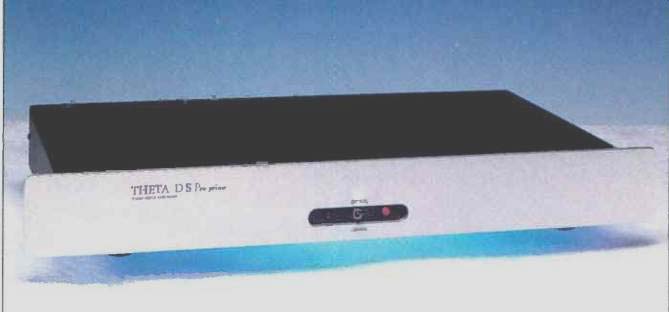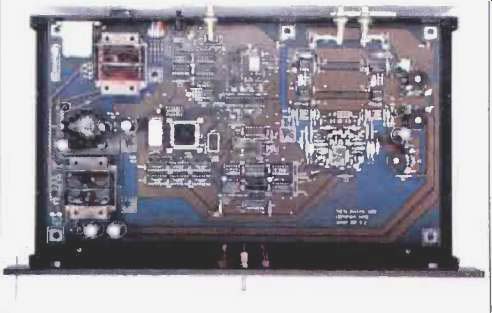
Company Address: 5330 Derry Ave., Suite R, Agoura Hill, Cal. 91301.
The Theta DSPro Prime, a $1,250 D/A converter, is basically a one-bit system and is designed to correct four sonic problems that have caused such systems to disappoint many people.
The first of these problems is that the image size one-bit systems present seems constant, almost regardless of the performance, which magnifies solo instruments and singers. There is also a tendency to center the image, compressing its spread from right to left.
The soundstage is shallow, often two dimensional. And finally, there is a lack of harmonic detail, or "air." Notes are not harsh, yet they lack overtones and subtle detail, especially with cymbal, flute, and sometimes voice. Occasionally the term MASH seems all too appropriate.

According to Theta, all one-bit systems to date have used full, 16-bit digital input filters, purchased as chips from Philips, Sony, Yamaha, and others. Such chips seem to be redesigned annually, but their improvements are only incorporated into new units, not those already in the field.
The Theta DSPro Prime is the first audio product to combine true programmable digital signal processing with one-bit D/A conversion. It uses a ROM-driven Motorola DSP56001 microprocessor to provide the first 20-bit, four-times oversampling function. This allows freedom from obsolescence by allowing inexpensive software upgrades. The "four-over" signal is sent to a Signetic/Philips SAA7350 one-bit D/A converter that provides the noise shaping, the one-bit/64-times over-sampling, and the conversion. Theta believes the ROM-driven microprocessor provides a digital filter that allows the time domain as well as the frequency domain to be optimized. The sonic benefits Theta seeks from this approach are a fully extended high-frequency response as well as superior imaging, depth, detail, and sound-stage realism.
The Prime has other important features. It has large power supplies for both the analog and digital sections, is exceptionally well shielded and free of hum fields, and has a pilot light to show that it is receiving a digital signal (which may seem like a minor feature until you try to trouble-shoot a unit with out one). It uses some 71 bypass capacitors per unit to reduce digital hash and noise. The analog section has been specially designed to match the requirements of one-bit D/A converters, rather than adapted from other players, and it has been isolated from the r.f.-generating digital circuits.
While a mix of advanced design features should be provided in an out board decoder in this price range, I have seen a number of similar units that are far less sophisticated and well made. Several also generated memorable hum fields and required placement well away from phono units and-in one case-from other digital equipment.
We all have heard countless claims about the technical merits of different digital processors, but the real issue is whether a given unit actually delivers superior sound quality. The DSPro Prime does, and this--not Theta's technical claims--is why I have chosen to review it.
The DSPro Prime does not eliminate all of the problems in the other one-bit and reduced-bit machines I have heard to date, but it does provide significant improvements in each area where the others have fallen short:
Image size is fully realistic. While all CD players exhibit variations in image size, and only the producer of a given recording can know what image size accurately reproduces the original sound, the DSPro Prime is both realistic and exhibits the proper variation in image size to provide a credible illusion of realism. Unlike other one-bit and reduced-bit units I have heard, the Prime also reproduces the kind of subtle imaging characteristic of top-priced, high-performance DACs.
The overall soundstage and imaging are still slightly centered, but not to the unrealistic extent of many machines using one-bit technology.
The depth is good to very good, although it does not rival that of top-of-the-line decoders from Krell, Wadia, and even Theta. Harmonic detail, or "air," is also very good. Once again, the more sophisticated decoders that cost well over twice the price of the DSPro Prime do better. The Prime is, however, fully competitive with any of the other de coders in its price range that I have yet heard in its ability to reproduce the essential subtleties of music. It man ages to provide an exceptional degree of upper midrange and treble detail without hardness or a loss of harmonic richness.
More generally, the Prime has a well balanced mix of sound characteristics. Unlike some separate decoders that seem to try to sound different, rather than accurate, there is no exaggeration of the size of the soundstage. Musical dynamics are very well handled, at both low and high levels, and the sound is consistently good with choral music, grand opera, and symphonies like Mahler's Eighth. There are many Compact Disc players that produce minor sonic oddities when playing complex large-scale music.
If I were shaping the sonic palette of the Prime, I would like a touch more bass energy and musical depth. I also might choose an upper midrange and treble balance that is slightly softer and that sounds a bit less forward. This, however, is a matter of personal taste rather than proper performance. I should also note that I have yet to hear a D/A converter anywhere near this price range that could combine such a mix of sound characteristics with the level of upper octave excitement provided by the Prime.
The Theta DSPro Prime is one of a handful of units I have heard in the $1,000 to $2,000 price range that really justifies its price. I have also been impressed with the Sony CDP-X777ES and the Proceed PDP-2 and PCD-2, but there is no question that the Theta DSPro Prime offers a unique mix of sound attributes. Further, the Prime makes a major improvement in the sound of many LaserDisc players, and its built-in upgrade capability is a tremendous asset. Digital sound is constantly improving, and any unit that can already deliver outstanding sound and take advantage of the changes in the state of the art, offers exceptional value for the money.
-Anthony H. Cordesman
Also see:
Theta Digital DS PRO Generation V D/A Converter (Feb. 1995)
Theta DS Pre Preamplifier (Auricle, Sept. 1989)
Vacuum Tube Logic Straight-Line D/A Converter (Nov. 1992)
Vimak DS-2000 D/A Converter and Preamp (Nov. 1992)
(adapted from Audio magazine, Nov. 1992)
= = = =